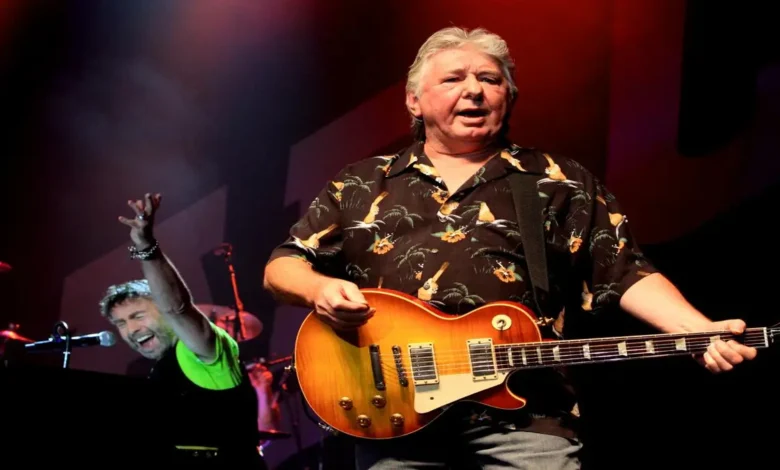
Mick Ralphs: The Guitar Maestro Behind Rock Legends
Mick Ralphs is one of those rare musicians whose legacy resonates through decades of iconic rock music. Known for his foundational work with Mott the Hoople and Bad Company, Ralphs carved a niche as a guitarist and songwriter with unmatched instinct and style. His riffs, melodies, and understated brilliance shaped the soundtracks of generations. Despite living largely outside the public eye in recent years, his influence continues to echo in the music industry.
In this deep dive into Mick Ralphs’ life, career, and contribution to rock history, we’ll explore not only his professional milestones but also his creative ethos, the bands he helped form, and the signature sound that made him a legend. This article breaks down Ralphs’s journey with expert analysis and a fan’s admiration written casually, yet with the expertise you’d expect from a seasoned rock historian.
Early Life and Musical Beginnings
Mick Ralphs was born in Herefordshire, England, where music played an integral role in shaping his childhood. Like many great rock artists of his era, he was deeply inspired by early blues records and the pioneering sound of American rock and roll. This early fascination with guitar-based music helped fuel his desire to learn the instrument from a young age.
By his teens, Ralphs had already begun playing in local bands. His love for the guitar was evident, and it wasn’t long before he became known for his smooth, blues-inflected playing style. There was a subtle confidence in his riffs, and though he rarely sought the spotlight, he knew how to command attention when the music started. It’s no surprise that this talent soon led him to something greater.
The Rise of Mott the Hoople
Mick Ralphs’ career truly began to take off when he became a founding member of Mott the Hoople in the late sixties. The band, known for its glam rock aesthetic and raw energy, started as a somewhat underground act but quickly built a cult following. Ralphs’ guitar work provided the sonic glue that held the band’s eclectic sound together.
It was during his time with Mott the Hoople that Ralphs proved himself not only as a skilled guitarist but also a talented songwriter. Tracks like “Rock and Roll Queen” and “One of the Boys” highlighted his ability to craft catchy riffs and memorable choruses. These songs stood out in the band’s catalog and helped define their rebellious yet sophisticated sound.
The collaboration with frontman Ian Hunter created a compelling dynamic. Ralphs brought the crunch and groove, while Hunter added lyrical flair and vocal fire. Together, they pushed Mott the Hoople into the mainstream, especially after they collaborated with David Bowie, who produced their hit “All the Young Dudes.”
Founding Bad Company: A New Chapter
After a successful run with Mott the Hoople, Mick Ralphs made a career-defining decision to leave the band and co-found Bad Company. This move would solidify his place among rock royalty. Alongside Paul Rodgers, Simon Kirke, and Boz Burrell, Ralphs helped shape one of the most iconic rock supergroups of the seventies.
Ralphs played a critical role in developing Bad Company’s sound. His guitar work on tracks like “Can’t Get Enough” and “Movin’ On” became instantly recognizable. “Can’t Get Enough,” in particular, was built around a riff Ralphs originally wrote while still with Mott the Hoople. It became a defining anthem of the band and showcased his knack for writing hooks that rocked arenas.
What made Ralph’s contribution to Bad Company so vital was his ability to balance power and melody. His rhythm playing was tight, his solos expressive but never over-indulgent. This grounded the band, allowing Rodgers’ vocals to soar while providing the musical weight that anchored every track.
Guitar Style and Musical Influence
Mick Ralphs is often celebrated for his tasteful, economical playing. Unlike many guitarists who sought to dazzle with sheer speed or complexity, Ralphs focused on groove, feel, and tone. His approach was rooted in blues, but he layered it with rock sensibilities that felt timeless and bold.
One of Ralph’s trademarks was his use of open tunings, especially the D tuning he used on “Can’t Get Enough.” This gave his playing a distinctive voice and allowed him to explore chord voicings that were both rich and raw. His rhythm work was tight and punchy, providing the backbone for Bad Company’s biggest hits.
As a lead guitarist, Ralphs was never flashy, but every solo he played served the song. That’s what set him apart. He wasn’t trying to prove a point; he was creating mood and movement. It’s no wonder that many guitarists cite him as a major influence, even if his name isn’t always the first to come up in mainstream conversations.
Songwriting Contributions
Beyond his guitar work, Mick Ralphs was an accomplished songwriter. He had a gift for melody and a feel for structure, knowing exactly when to add a twist or pull back for effect. Many of Bad Company’s and Mott the Hoople’s most beloved songs bear his creative stamp.
He often collaborated with vocalists, bringing a strong musical foundation to their lyrical ideas. But even when writing alone, Ralphs had a clear vision. His songs typically blended straightforward rock with subtle layers—clever chord progressions, unexpected bridges, or dynamic shifts that added depth to the arrangement.
Tracks like “Ready for Love,” “Seagull,” and “Good Lovin’ Gone Bad” exemplify his strength as a songwriter. They carry emotional weight, groove hard, and linger long after the music ends. It’s songwriting like this that helped elevate both bands beyond their contemporaries.
Life on the Road and in the Studio
Touring was a major part of Mick Ralphs’ life during his peak years. From packed arenas to global tours, he was the quiet force that brought stability to the chaos of the rock and roll lifestyle. He wasn’t the most flamboyant member of the band, but he was the anchor.
Ralphs thrived in the studio environment. He had an ear for tone and texture, often working closely with producers to fine-tune the band’s sound. His meticulous nature didn’t hinder creativity; instead, it sharpened it. Ralphs knew how to take a rough musical idea and polish it into a timeless track.
Despite the madness often associated with rock tours, Ralphs maintained a relatively grounded persona. He was focused on the music, not the fame. That humility translated into his work ethic and the respect he earned from fellow musicians.
Legacy and Influence on Rock Music
When discussing the great guitarists and songwriters of classic rock, Mick Ralphs deserves a place at the table. His work with both Mott the Hoople and Bad Company shaped the direction of rock music in the seventies and beyond.
Bands that followed took inspiration from Ralphs’s approach—balancing melody and muscle, crafting guitar parts that served the song rather than overshadowed it. You can hear echoes of his playing in acts from Tom Petty and the Heartbreakers to The Black Crowes and even newer rock revivalists.
Mick Ralphs’ influence is not limited to sound alone. His decision to pursue authenticity over flash became a model for countless musicians who cared more about longevity than the limelight. His contribution to British rock, in particular, is often underrated, yet deeply embedded in the genre’s history.
Later Career and Health Challenges
In the years that followed Bad Company’s initial success, Ralphs continued to play and record music. While the band underwent various lineup changes and reunions, Ralphs remained a core figure during its most important eras. He also released solo material, which showcased his more introspective, experimental side.
Unfortunately, health issues eventually forced Ralphs to step back from performing. A stroke he suffered after a Bad Company tour led to complications that made touring and recording difficult. Despite these setbacks, fans continue to celebrate his legacy and hope for continued recovery and well-being.
Even as he stepped out of the spotlight, his love for his music never dimmed. Tributes from fans and fellow musicians alike continue to pour in, underscoring just how much Mick Ralphs means to the world of rock and roll.
Relationship with Fellow Musicians
Mick Ralphs was always respected among his peers. Musicians who worked with him describe him as humble, collaborative, and incredibly skilled. His quiet demeanor often belied the powerful impact he had in the studio and on stage.
His partnership with Paul Rodgers was particularly fruitful. Their chemistry was undeniable, blending Ralphs’ riff-based songwriting with Rodgers’ soulful voice. Likewise, Ralph’s camaraderie with Simon Kirke and Boz Burrell created a rhythm section dynamic that gave Bad Company its groove.
Outside of his main bands, Ralphs also worked with several other artists, often contributing guitar work or production insight. His ability to adapt while still maintaining his musical identity made him a sought-after collaborator for many years.
Fans and Cultural Impact
The fans of Mick Ralph span generations. From die-hard Mott, and the Hoople followers to those who discovered Bad Company through classic rock radio, Ralphs’ music continues to resonate. His songs have been used in films, commercials, and TV shows, introducing his work to new audiences over time.
In fan circles, Ralphs is often considered the “musician’s guitarist”—someone whose depth of skill is truly appreciated by those who understand the craft. He may not be as well-known as some of his flashier contemporaries, but in terms of influence and respect, he’s at the top of the list.
Culturally, Ralphs helped define the sound of an era. His music captured the grit and grandeur of the seventies, and his legacy lives on in every power chord and blues lick that aims to blend emotion with energy.
The Enduring Sound of Mick Ralphs
Today, Mick Ralphs’ music continues to be rediscovered and reappraised. His guitar tone, songwriting, and understated brilliance remain a masterclass for musicians and fans alike. Whether it’s the opening riff of “Can’t Get Enough” or the introspective beauty of “Seagull,” his work offers something timeless.
In a world full of trends, Mick Ralphs stayed true to the music. He let his guitar speak for him, and what it said still matters today. His place in rock history is secure, not just because of the bands he played in, but because of the heart and soul he brought to every note.







